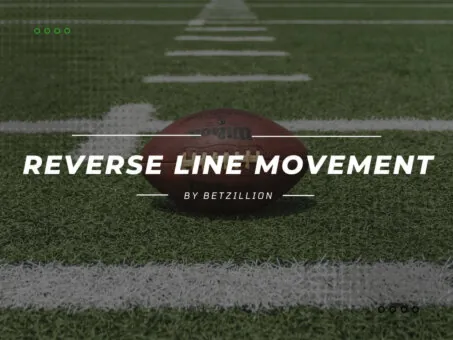Sports Betting Lines Explained

Understanding sports betting lines is essential for every bettor. It helps you know the wagers to place and those to ignore. Good knowledge of these lines, how they move and finding value will guarantee wins in different sports. Hence, it’s essential to learn how to use them.
What Is a Betting Line?
A betting line involves the bookmaker setting odds determining the underdog or favorite team in a match or competition. Due to this handicap, there’s a margin between the 2 teams that creates only 2 possible outcomes for your stake.
The handicap from a betting line sets the necessary values for betting on the sport. Examples of sports you can wager on include soccer, football, hockey, basketball, and more.
An excellent example of an online sports betting line is in a match involving Milwaukee Bucks and Phoenix Suns. Before placing a bet on this event, it’s imperative to know the favorite and underdogs. If the latest odds for Phoenix Suns is -500 and that of Milwaukee is +375, the latter team is an underdog in the match.
The line from the bookie in the match against the teams gets even in the contest. Hence, both teams have equal chances of winning due to the imposed handicaps. For the best outcome wagering using the lines, it’s advisable to utilize tips, predictions, and expert analysis.
How Betting Lines Work
Before placing a bet, it’s imperative to understand the betting line meaning, the working mechanism and how to read them. It will help you comprehend the different types of odds, how to read them, and other imperative details.
Who Creates the Betting Lines?
Bookmakers are responsible for creating betting lines. These sports betting firms employ an odds compiler that helps set the odds for a specific event. Sportsbooks analyze several factors and use primary sports information before creating sportsbook betting lines.
The experts responsible for creating the betting lines work based on 2 different types of markets. One is the statistical market, and the other involves significant insight or intuition.
For the statistical market, all it involves is counting the number of times a certain event took place. For instance, how often the home team won in the previous 15 matches. Note that betting lines may get complicated during creation because the compilers are also responsible for monitoring the bookmaker’s financial position.
Results from the analysis of the sportsbook’s finances also influence the lines. Hence, the creation of betting lines involves complex processes. Another significant factor the compiler considers when setting lines is the odds of other reputable bookmakers. While the values from other bookies are essential to consider, they perform individual analyses.
During the creation of the lines, wagering volume significantly influences final odds and how betting lines work. Bookies pay attention to betting volume to cut the odds on a selection that receives a high number of wagers.
American, Decimal, & Fractional Odds
The American, decimal, and fractional odds are methods that bookies employ to display betting lines to bettors. Individuals should know how to read each of the 3 types of odds for a good payout. Here’s more detail about the 3 kinds of odds:
- American Odds
Another name for this type of odds is the US or moneyline odds. It’s a prominent style of displaying betting lines in bookies. You can recognize the American odds by the positive (+) or negative (-) signs accompanying a number.
If bettors place a wager using American odds with odds of +500, they will get a $500 payout if it succeeds. The bettor receives $100 if the initial American odds are -500 and it grows. Note that the latter requires the individual to place a wager worth $500. Due to this type of odds payout, there’s an evident betting line.
- Decimal Odds
Unlike the American odds, the decimal doesn’t involve a positive or negative symbol. They signify the amount a bettor wins for every unit dollar stake. Note that the number in the decimal odds defines the final payout, not the profit.
For a bettor to know the final payout in a betting line, it’s important to multiply the stake by the odd decimal number. For example, a bettor can know the total payout after a bookmaker sets a betting line for a team to 1.83. If the individual places a $100 wager, the outcome will yield 100 x 1.8, which equals $180.
- Fractional Odds
As the name implies, fractional odds involve values bookies display as fractions. In sportsbooks, this type of odds influences the betting line because it consists of a ratio of profit to stake. A team with fractional odds of 9/2 means the bettor wins $9 for every $2 stake.
The fractional lines matter in every sporting event and are straightforward to comprehend. Teams with lower fractional odds are usually the favorite, while those with higher values are typically underdogs.
What Do the Plus (+) and Minus (-) Mean in Sports Betting?
Both the plus and minus signs are common in the American odds. They define whether the team is rated as an underdog or favorite. The 2 characters also influence the payout of a bettor depending on the odds value. If a minus (-) precedes a number, it signifies the team is a favorite. The squad is an underdog if a positive (+) sign precedes any number for its odds.
It’s imperative to explain both symbols using an example. Hence, if the Lakers have odds -250 and the Warriors have +200, it has 2 different significances. The Lakers are the favorite for that game, and the Warriors are the underdogs. When the game starts, the lines for both squads become even.
How do the minus, plus, and signs influence payout in sports betting? Considering the same instance above, the bettor gets a $200 payout for a $100 successful stake on Warriors. On the other hand, the individual wins $100 for a $250 fortunate wager on Lakers.
Apart from the significance of the plus and minus signs in American odds, they also work for totals. For instance, a bettor can wager on the final score of an NFL match between 2 major teams. If the odds for over 45 are +120 and under 45 are -100, it signifies that “under 45” is the favored selection.
Why Do Betting Lines Change?
In sportsbooks, betting lines change due to specific actions from the bookie. There are 2 major reasons for moving betting lines, which are:
- To encourage/discourage bettors from placing a wager on a selection
Bookmakers employ the fundamental principles of demand and supply when setting betting lines. If a certain betting volume is more than what a bookie desires, they make it less attractive for bettors on their site.
Sportsbooks also encourage bettors to wager on a particular selection if the betting volume is insufficient. The primary goal of bookies when changing lines is to ensure they profit from each selection.
- External Effects
Apart from the movement due to betting action, external effects are also significant causes. Events like weather changes, injuries, goalies, or last-minute scratches are examples of what causes sports betting line movement.
For instance, weather conditions like snow can affect American Football or Soccer. The game will have fewer points than a typical match, influencing the over/under betting line. Similar to weather, other factors like injuries also cause a change in the pre-set betting line due to unforeseen possibilities.
Select bookmakers also tail sharps, which means they monitor specific expert bets on their websites. Tailing sharps usually cause a significant change in the betting line.
How to Read Betting Lines

Reading betting lines is straightforward but requires knowledge of the different betting lines. Hence, the first move to reading a betting line is to comprehend the wagering type you select from the bookmaker.
Here are the steps on how to read betting lines for different kinds of wagers:
- Determine the type of betting line (American, fractional, or decimal)
- Identify the favorite and underdogs
- Make a selection
The Point Spread Bets
Point spread bets are associated with high-scoring sports like football and basketball. They are also applicable in other sports and allow bettors to enjoy a high payout. The wager involves betting on the margin of victory of a specific game. In the point spread, the bookie favors the better team or player by a particular number of points.
An example of the point spread wagers is in a game involving 2 NFL teams like the Patriots and Bengals. If the Patriots are -6.5, they are the favorite due to the negative sign. The Patriots need to win by 7 points or more for bettors to enjoy the win from the current odds.
If the Bengals are +6.5, they need to lose by 1 to 6 points or win the game for bettors to succeed in the wager. Note that the plus sign behind the 6.5 value depicts they are the underdog. In cases where the point spread is a whole number, like Bengals +7 and Patriots win by 7 points, it equals a push. For this reason, the bookie will refund all bets.
Here are the steps to placing point spreads using betting lines:
- Select a reputable bookmaker
- Pick a suitable sport for your point spread wager
- Click the spread you want to wager on in the game module
- Navigate to the betting slip in the bookmaker
- Enter the appropriate betting amount
- Place the bet
Moneyline Bets
Most sportsbooks and experts regard moneyline wagers as one of the most straightforward bet types. It’s simpler than other wagers like the point spread or parlay. Another name for this wagering type is straight bets because it involves betting on the player or team that wins. The sportsbook will provide the proper payout if a bettor makes the correct selection.
With the moneyline wagers, the favorite usually carries a minus sign next to the odds value. For the underdogs, their odds should have a positive value (+). An example of a moneyline wager is a competition involving 2 teams in the NBA (Lakers and Rockets).
If the Lakers have odds of -120, a bettor needs to wager $100 to win $120 for this favorite. Odds of +134 for the Rockets signify that bettors will win $134 if they place a $100 stake. Overall the moneylines are simple for beginners and are also straightforward to utilize by bettors in bookies.
Here are the steps to placing moneylines using betting lines:
- Select a top bookie and create a free account
- Pick a sport for your moneyline wager
- Select the athlete or team for the bet
- Navigate to the betting slip in the bookmaker
- Enter the appropriate betting amount
- Place the bet
Proposition Bets
Prop bets are highly essential when dealing with sports line betting. This type of wager is similar to the “futures,” but there’s a significant difference between them. Proposition bets offer various possibilities, which makes them highly profitable.
There are various types of prop bets in the sports betting industry. Major examples include wagers on the team point totals, “will it occur,” individual performances, first on the team, and timing wagers. A fundamental example of prop bets is deciding whether a coin toss is a head or tail.
Some benefits of prop wagers include flexibility in wagering, entertainment, and high profitability. Note that this type of wager doesn’t usually resolve in a push, unlike the over/under.
Here are the steps to placing props using the best sports lines for today:
- Select an online bookie and create an account
- Pick a sport for your wager
- Select an event
- Navigate to the betting slip in the bookmaker
- Enter the appropriate betting amount
- Place the bet
Point Total Bets
Another name for the point total wagers is over/under. It’s a bet you place on a specific game’s total combined score. The game’s essence is predicting whether a match’s overall score will be over or under a specific amount.
The point total wager doesn’t involve guessing the specific point total, and it’s common among bookies. An example of this type of wager is a game between the Chiefs and the 49ers. If a bookmaker sets the point total stakes as 52, it means a bettor can wager on either over or under 52.
If the final value or total for the match is 35-22 against the 49ers, the sum of points is 57. Bettors who placed bets on totals above 52 will win the wager, and those selected under will lose.
Here are the steps to placing point total stakes using betting lines:
- Select an online sportsbook
- Pick a sport for your point total wager
- Select a sporting event
- Navigate to the betting slip in the bookmaker
- Enter the appropriate betting amount
- Place the bet
When Is the Best Time to Place a Bet?
Now that you know betting lines can change or move, you must know the best time to place a bet. There’s no specific time that is the best, but there are various suitable periods to consider as a bettor. Here are 3 significant ones to consider today:
- When the Lines are Released: If you’re a good handicapper, you’ll find more value in wagering on the early lines that bookies release. Note that the early bookmaker lines move fast because many sharp bettors place wagers on them.
- Few Minutes before the Game Starts: For the most reasonable and expected outcome of your wagers, it may be advisable to bet minutes before a match begins. This method reduces loss due to certain happenings, like absence from player injuries or weather conditions.
- In-Play Wagering: Placing live wagers helps bettors to make less hasty decisions. In-play bets ensure that individuals can comprehend the trend of the game and make selections based on it.
What Sports Can Betting Lines Be Used For?
Final Words
Betting lines are important for setting the odds for a game and determining the favorite or underdog in a competition. Understanding betting lines, how they move, and when to place your wager guarantees a good payout.
Frequently Asked Questions
-
What are the betting lines?Betting lines involve a bookie setting gambling odds to determine the underdogs or favorites in a game. There are only 2 major possibilities for bettors in betting lines: a loss or win in wagers. The compiler is an individual that takes responsibility for the creation of the lines.
-
How do lines work in betting?Lines tend to change depending on the betting action and other major factors. These lines determine the better team in a match and play a role in the final payout. Sportsbooks are responsible for setting the lines to ensure they make a maximum profit off wagers.
-
What does +1.5 mean in betting?In sports betting, +1.5 signifies that the team associated with that value is 1.5 underdogs. In point spreads, the squad needs to win by 2 or more goals for bettors to win their wager. If individuals place a bet for under 1.5, they will lose.
-
How do you read NBA betting lines?Most sportsbooks display the NBA betting lines using the American odds. If an NBA team has odds of +120, the bettor will win $120 off a $100 wager. The individual will also win $100 if the odds are -120 for a $120 bet.
-
How do you read football betting lines?Most football betting lines employ the fractional method of odds. Hence, the odds are in a profit ratio to the bettor’s stake. When the fractional odds for a team are higher than the other, the latter team is a favorite.
-
What do O and T mean in betting lines?Sportsbooks use O and T alphabets for the point total wagers. O signifies over, which means a bet above the predetermined total. T also represents the projected total for 2 teams from a sportsbook.
-
Still have questions?
Ask our experts
Related articles
Action and No Action in Sports Betting
Futures Betting






